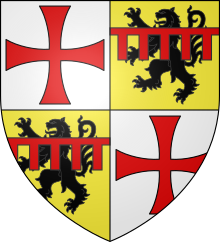21st Grand Master of the Knights Templar
.mw-parser-output .hidden-begin{box-sizing:border-box;width:100%;padding:5px;border:none;font-size:95%}.mw-parser-output .hidden-title{font-weight:bold;line-height:1.6;text-align:left}.mw-parser-output .hidden-content{text-align:left}@media all and (max-width:500px){.mw-parser-output .hidden-begin{width:auto!important;clear:none!important;float:none!important))You can help expand this article with text translated from
the corresponding article in Spanish. (October 2020) Click [show] for important translation instructions.
Machine translation, like
DeepL or
Google Translate, is a useful starting point for translations, but translators must revise errors as necessary and confirm that the translation is accurate, rather than simply copy-pasting machine-translated text into the English Wikipedia.
Consider
adding a topic to this template: there are already 5,023 articles in the
main category, and specifying|topic= will aid in categorization.
Do not translate text that appears unreliable or low-quality. If possible, verify the text with references provided in the foreign-language article.
You must provide
copyright attribution in the
edit summary accompanying your translation by providing an
interlanguage link to the source of your translation. A model attribution edit summary is Content in this edit is translated from the existing Spanish Wikipedia article at [[:es:Guillermo de Beaujeu]]; see its history for attribution.
You may also add the template ((Translated|es|Guillermo de Beaujeu)) to the
talk page.
For more guidance, see
Wikipedia:Translation.
Guillaume de Beaujeu, aka William of Beaujeu (c. 1230 – 1291) was the 21st Grand Master of the Knights Templar, from 1273 until his death during the siege of Acre in 1291. He was the last Grand Master to preside in Palestine.
Biography
Guillaume was born around 1230, to be the youngest son of Guichard II of Beaujeu, Seigneur of Montpensier and Catherine, daughter of Guillaume VIII son of Dalfi d'Alvernha.
He joined the Knights Templar in 1253, where he probably participated in the Seventh Crusade. He later went to the Kingdom of Jerusalem by 1260 or 1261, then he was captured during an ambush in the region of Tiberias, but released shortly after along with John II of Beirut and John de Embriaco. He was also part of the War of Saint Sabas, which deeply divided the nobility of the Crusader States and military orders. Hence, Baibars, Mamluk Sultan of Egypt, took the opportunity to conquer many Christian fortresses including Beaufort Castle, and destroy the Principality of Antioch.
In 1271, he became commander of the Templars in Tripoli. Later on, he was appointed as Grand Master of the Knights Templar to succeed Thomas Bérard in 1273. During his tenure the new Mamluk Sultan, Qalawun, easily conquered Latakia, after an earthquake in March 1286, which was the only remaining port in the Principality of Antioch, followed by the County of Tripoli in 1289, which had ignored Beaujeu's warnings. In 1290, Qalawun marched on Acre, the capital of the remnant of the Kingdom of Jerusalem, but died in November before launching the attack. His son Al-Ashraf Khalil, however, decided to continue the campaign. Beaujeu led the defence of the city.
At one point during the siege, he dropped his sword and walked away from the walls. His knights remonstrated. Beaujeu replied: "Je ne m'enfuis pas; je suis mort. Voici le coup." ("I'm not running away; I am dead. Here is the blow.") He raised his arm to show the mortal wound he had received - an arrow had penetrated his mail under his armpit so that only the fletches were visible. Beaujeu died of his wound and the city fell to the Mamluks, signalling the end of Crusader occupation of the Holy Land.
